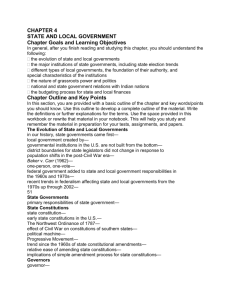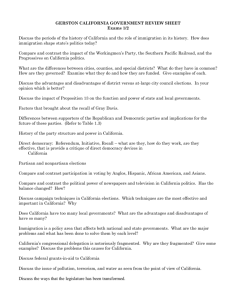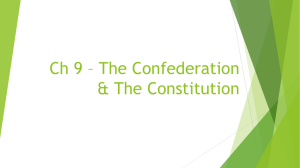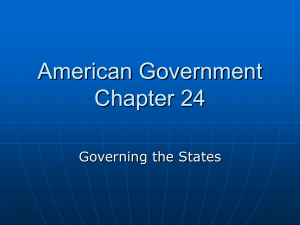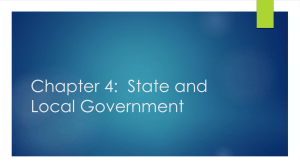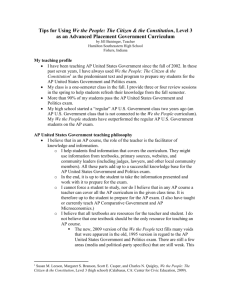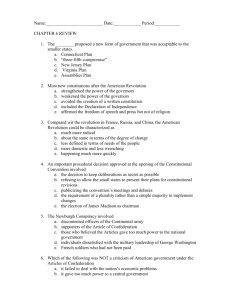STATE AND LOCAL GOVERNMENT
advertisement
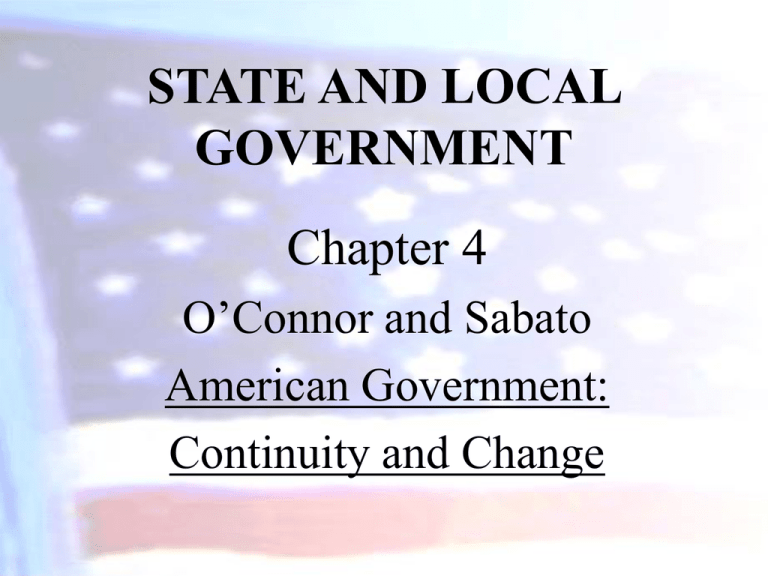
STATE AND LOCAL GOVERNMENT Chapter 4 O’Connor and Sabato American Government: Continuity and Change STATE AND LOCAL GOVERNMENT In this chapter we will cover… 1. The Evolution of State and Local Governments 2. Grassroots Power and Politics 3. State Governments 4. Local Governments 5. Relations with Indian Nations 6. Finances The Evolution of State and Local Governments Governance in the United States is by multiple authorities. Sometimes they work together, other times they seem to work at cross purposes. – At independence, the thirteen colonial governments became states tied together in a loose confederation under the Articles. – They formed a federal union in the late 1780s in order to address the weakness of the confederative model. – States create and determine the powers of local governments in our system. The Evolution Continued – In 1962, the Supreme Court forced the states to redistrict and become more representative of the states’ population. In Baker v. Carr, the Court applied the Fourteenth Amendment's Equal Protection Clause to voters. • The ruling of “one man, one vote” required that legislatures redistrict so that all districts have an equal number of constituents. The Evolution Continued • During the 1960s and 1970s, the national government added to the responsibilities of the state and local governments. –Federal programs to fight poverty, promote urban renewal, and protect the environment were administered at the state and local levels. The Evolution Continued • In the 1990s, the clear message was that state and local governments were increasingly important. • States, cities, and local governments are taking bold initiatives and establishing direct ties with each other and with other countries to spur economic growth. • Governors have become important national actors. State legislators, county officials, city managers, and other officials now travel the globe promoting the interests of their constituents. Grassroots Power and Politics • Most small towns have a local dynasty--some big towns have them, too. • State politics, and particularly local politics, are often more personal, non-partisan, and issueoriented than national politics. • A full understanding of what happens at the grassroots includes an appreciation of local elites, local issues, local news media, and issue-specific organizations through which local and state governments make and implement policies. State Governments • The primary responsibilities of state governments are: – – – – – – education public health transportation economic development criminal justice the licensing and regulation of professions (teachers, social workers, doctors, lawyers, barbers/stylists, architects, etc.) • Additionally, states have become more active in welfare and environmental issues both on their own and as administrators of national programs. State Constitutions • State constitutions generally limit the powers of the state governments. • After the Civil War, the states of the South were forced to adopt new constitutions acceptable to the victorious North. Often these constitutions gave significant powers to former slaves and disenfranchised the traditional elites. • After Reconstruction, these states adopted yet newer constitutions reflecting white distrust of power and providing for weak governments. State Constitutions • Western states also chose weak governments. • Many Western states allow voters to enact legislation through initiatives and recall elections to remove officials from office. • The trend has been to strengthen state governments so that they can more effectively deal with important issues. • Terms of governors have been lengthened, and they have been given additional authority over spending. • Legislatures have become full-time with more adequate pay, and courts were strengthened. Governors • Governors are the chief executive officers of the states. They have both ceremonial and policymaking roles. • In most states, governors: – – – – propose the budget have veto authority have appointment powers have power to pardon someone who has been convicted of a crime – can commute sentences, grant parole, and extradite individuals State Legislatures • All states except Nebraska have bicameral legislatures. • By 1999, twenty states limited the number of terms a legislator could serve. The limits range from six to twelve years. • State legislatures are still primarily parttime bodies. There is abundant turnover-over 25% of seats each election. State Courts • The primary function of courts is to settle disputes. Criminal behavior, family law, contracts, and land use are all issues for state law and state courts. • State court judges are are usually elected to the bench for a specific term. • Sixteen states have partisan elections to the bench, another sixteen states hold nonpartisan elections. • Six states use gubernatorial appointments. The remaining states use the Missouri Plan in which the governor selects appointees from a list prepared by an independent panel. Elections • Elections are the methodology for determining who will direct the institutions of state government. • Highly partisan… however, campaigns are usually centered on individual candidates. Patterns of Party Competition in State Legislatures Direct Democracy • Direct initiative: The process in which voters can place a proposal on a ballot and enact it into law without involving the legislature or the governor. • Indirect initiative: The process in which the legislature places a proposal on a ballot and allows voters to enact it into law without involving the legislature or the governor. Local Governments Formed by a charter—a document that specifies basic procedures, politics, and institutions of any local municipality. Similar to a constitution. Counties: subdivisions of every state except Connecticut and Rhode Island. Towns: government in which everyone is invited to an annual meeting for elections, budget discussions, etc. Municipalities: villages, towns, and cities Special Districts: school districts, etc. Types of Charters for Local Governments • • • • • Special Charters General Charters Classified Charters Optional Charters Home Rule Charters Executives and Legislatures Local governments have some or all of the following decision-making positions: • Elected executive: mayor, village president. • Elected council or commission: city council, school board, county board. • Appointed manager: city manager, school superintendent. Relations With Indian Nations • Treaties between the national government and Indian nations directly affect thirty-four states. • The status of Indian tribes today is that of “domestic dependent nations.” • The national government has ceded authority to the states, except for several specific areas such as gaming and criminal behavior. • The two most important features of federal-tribal relations for state and local governments are land rights and treaty provisions for hunting, fishing, and gathering. Finances • Unlike the national government, states and localities must balance their budgets. • States receive as much as 25% of their funds from Washington, D.C. • Local governments get as much as 15% of their money from the federal government. • Different governments depend on different taxes and fees for revenue. – States rely primarily on income and sales taxes. – Local governments tend to rely on property taxes and some sales tax income. – Both local and state governments levy users fees for parks, hunting licenses, tuition, and so on. State and Local Tax Burdens
